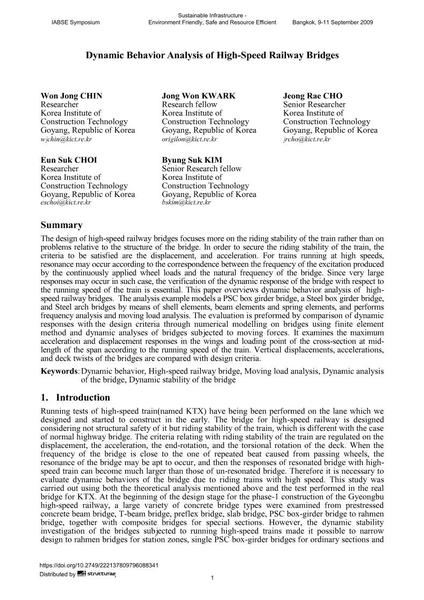Dynamic Behavior Analysis of High-Speed Railway Bridges

|
|
|||||||||||
Bibliographic Details
| Author(s): |
Won Jong Chin
Jong Won Kwark Jeong Rae Cho Eun Suk Choi Byung Suk Kim |
||||
|---|---|---|---|---|---|
| Medium: | conference paper | ||||
| Language(s): | English | ||||
| Conference: | IABSE Symposium: Sustainable Infrastructure - Environment Friendly, Safe and Resource Efficient, Bangkok, Thailand, 9-11 September 2009 | ||||
| Published in: | IABSE Symposium Bangkok 2009 | ||||
|
|||||
| Page(s): | 166-173 | ||||
| Total no. of pages: | 8 | ||||
| Year: | 2009 | ||||
| DOI: | 10.2749/222137809796088341 | ||||
| Abstract: |
The design of high-speed railway bridges focuses more on the riding stability of the train rather than on problems relative to the structure of the bridge. In order to secure the riding stability of the train, the criteria to be satisfied are the displacement, and acceleration. For trains running at high speeds, resonance may occur according to the correspondence between the frequency of the excitation produced by the continuously applied wheel loads and the natural frequency of the bridge. Since very large responses may occur in such case, the verification of the dynamic response of the bridge with respect to the running speed of the train is essential. This paper overviews dynamic behavior analysis of high- speed railway bridges. The analysis example models a PSC box girder bridge, a Steel box girder bridge, and Steel arch bridges by means of shell elements, beam elements and spring elements, and performs frequency analysis and moving load analysis. The evaluation is preformed by comparison of dynamic responses with the design criteria through numerical modelling on bridges using finite element method and dynamic analyses of bridges subjected to moving forces. It examines the maximum acceleration and displacement responses in the wings and loading point of the cross-section at mid- length of the span according to the running speed of the train. Vertical displacements, accelerations, and deck twists of the bridges are compared with design criteria. |
||||
| Keywords: |
dynamic behavior high-speed railroad bridge moving load analysis dynamic analysis of the bridge Dynamic stability of the bridge
|
||||
